
The eruption of Krakatau in 1883 is synonymous with cataclysm, and with good reason. Its eruptive power equated to several thousand atom bombs, and it killed around 36,000 people. But compared to the supervolcanoes that nearly wiped out humanity, or that may yet spell global catastrophe, it was a wet squib.
Find out about the magma doom machine buried under America’s oldest national park as I take you on a tour of …



